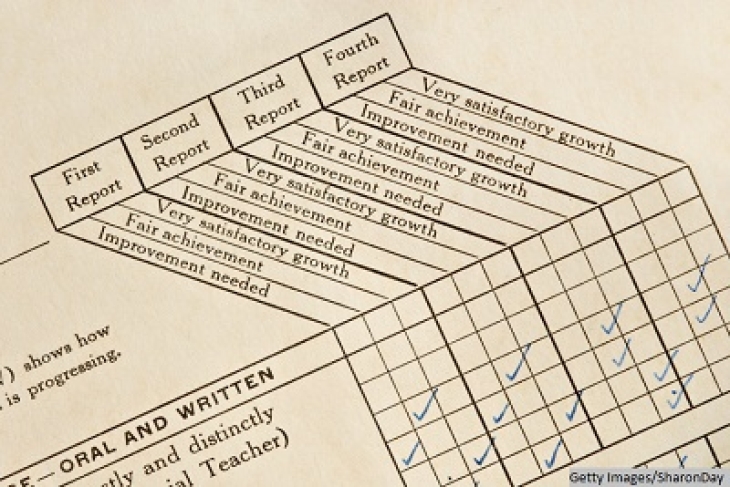Ohio has developed one of the nation’s best school report cards, packed with data and clear A–F ratings for schools and districts. In this light, the reports that parents receive on their own children’s state exam performance are doubly disappointing. Simply put, the current form of these reports is mediocre. They represent a missed opportunity to clearly convey where children stand academically, how well (or not) they are progressing in school, and how bright (or not) are their future education prospects.
Ohio can and should do a better job communicating with families.
The image below displays a snippet from a sample state test score report for 2015–16. The student’s name (Jane) and high school math score (706) are fictitious. The entire document is available at this link both for grades 3–8 and high school.
[[{"fid":"116795","view_mode":"default","fields":{"format":"default"},"type":"media","link_text":null,"attributes":{"height":"477","width":"875","style":"width: 500px; height: 273px;","class":"media-element file-default"}}]]
These score reports have a couple of helpful features that provide context and comparison, such as giving families the ability to relate their children’s scores to various averages. In this example, Jane’s math score lags behind these averages, which might raise flags for her parents. Additionally, the report breaks down the math test results by subtopics (e.g., ratios and proportions, modelling and reasoning) and even offers ideas, if only cursory ones, on how families can help their children improve in each area.
But the score reports also leave a murky picture of achievement. The headline on the front of the report, shown in the figure above, reads (emphasis added): “Jane’s score is 706. She has performed at the proficient level and meets standards for Mathematics.” That sounds great, but careful readers will observe the following note in the report’s glossary: “The accelerated level of performance suggests that a student is on track for college and career readiness.” So which is it? Is Jane doing fine by state standards, or is she off track academically because she hasn’t made it to “accelerated”? Policy wonks in Columbus will know that the discrepancy between the fine print and the headline is explained by Ohio’s failure to match its proficiency standards with college-and-career-ready benchmarks. But unless they’ve combed through the details, parents are likely to suppose—wrongly—that proficiency signifies being on track for college or the workforce after high school.
Instead of sending mixed signals, state policy makers should tell families straight-up whether their children are on track for college and career. This would be more in line with Ohio’s own commitment to ensure that students are well prepared for post-secondary education or the workforce. Readiness is at the heart of the state board of education’s vision statement, and it was even deemed a “social and moral obligation” by state policy makers when they wrote to federal officials last year (page 25).
State legislators should do their part by aligning proficiency with CCR benchmarks. ODE and the state board of education can pitch in by telling parents on their children’s score reports that proficiency does not match the readiness standard: They should do this in bold print and most certainly not bury the message in a glossary.
In addition to making this utterly fundamental change, Ohio policy makers should consider two other steps that would greatly improve communication with families.
- Report students’ statewide percentile ranks. As mentioned above, families can gauge where their children’s scores stand relative to their peers by comparing them to various averages at the state, district, school levels. This is a useful starting point, but the state could give parents much clearer information by reporting percentile ranks. In the example above, we know that Jane is below the statewide average—but just how far below? Is she at the forty-fifth or the twenty-fifth percentile? We don’t know, because the report doesn’t say. Reporting ranks would also allow parents of both high- and low-achieving students to annually track whether their children are holding steady, gaining ground, or falling behind their classmates. Nothing in the current report accomplishes that. Percentile ranks shouldn’t be a mystery: The ACT and SAT report them to test takers. Why not Ohio?
- Use predictive analytics to give families a better idea of the college trajectory of their children. With the help of analytic tools that companies like SAS have already developed, Ohio could let parents see which kinds of colleges their middle school children are likely to be admitted to four or five years into the future. The projections could be displayed on these score reports, as they would be based on state exam results. Much care, of course, would be needed in communicating them (they shouldn’t be presented as deterministic, and actionable steps should be offered to help change these trajectories). If done well and provided early in kids’ lives, this type of information could empower families to make sure their students are on track for success after high school.
Some will say that such candid information, projections, and advice aren’t the state’s role. After all, parents see quarterly report cards four times each year. In many cases, these reports offer timely and relevant information, especially in the absence of a state exam. But in a time of grade inflation, an A or B on the report card may not always mean what it should, especially if we believe that schools sometimes provide less-than-frank diagnoses of children’s academic performance. Report cards also help little when placing a child’s achievement into broader context. State exam results provide an essential extra: an independent checkup on achievement, akin to what an external audit supplies the shareholders of a company. Families deserve the truth about those results, both in relation to post-secondary readiness and to their children’s peers.
Ohio policy makers have made a good start by disseminating clear information about school performance. Now they need to be just as clear and informative about the performance of individual children.

